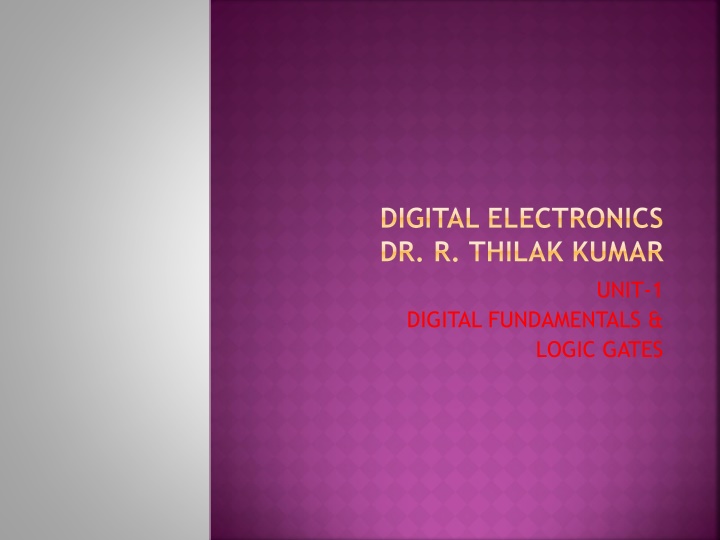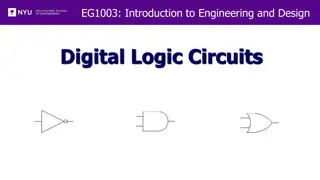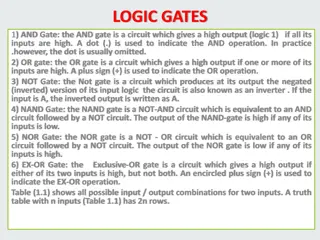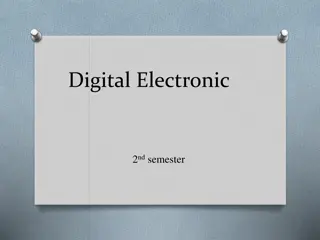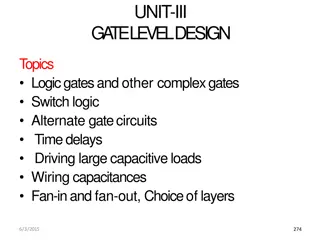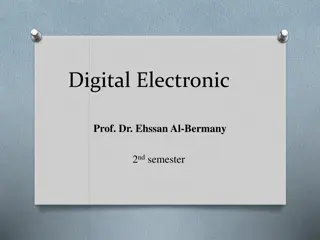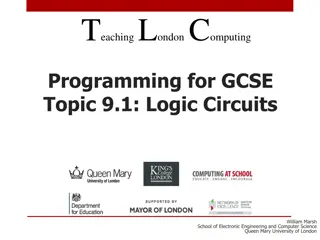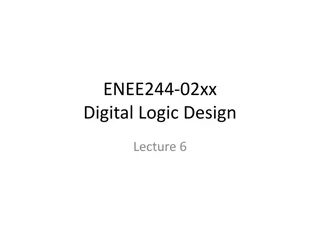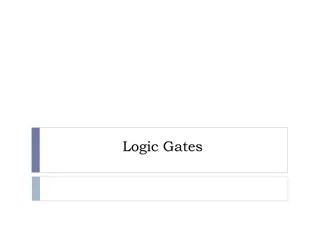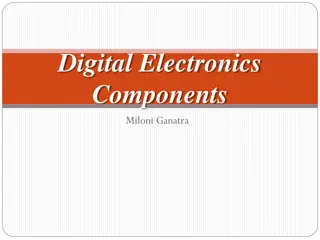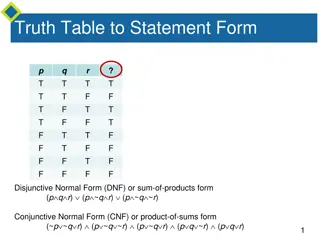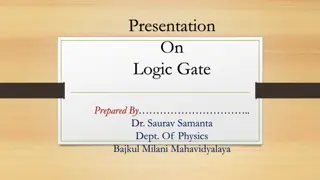Digital Fundamentals & Logic Gates Overview
This content provides an introduction to digital electronics, covering topics such as digital fundamentals, logic gates, number systems including decimal, binary, octal, and hexadecimal, and the binary number system. It explains how a digital system interprets positional numbers and includes detailed information on the decimal number system. The content also delves into the characteristics and uses of the binary number system, offering examples and calculations for better understanding.
Download Presentation

Please find below an Image/Link to download the presentation.
The content on the website is provided AS IS for your information and personal use only. It may not be sold, licensed, or shared on other websites without obtaining consent from the author.If you encounter any issues during the download, it is possible that the publisher has removed the file from their server.
You are allowed to download the files provided on this website for personal or commercial use, subject to the condition that they are used lawfully. All files are the property of their respective owners.
The content on the website is provided AS IS for your information and personal use only. It may not be sold, licensed, or shared on other websites without obtaining consent from the author.
E N D
Presentation Transcript
DIGITAL ELECTRONICS DR. R. THILAK KUMAR UNIT-1 DIGITAL FUNDAMENTALS & LOGIC GATES
NUMBER SYSTEMS Decimal Binary Octal Hexadecimal
A digital system can understand positional number where there are a few symbols called digits and these symbols represent different depending on the position they occupy in the number. A value of each digit in a number can be determined using The digit The position of the digit in the number The base of the number system (where base is defined as the total number of digits available in the number system). system only values
DECIMAL SYSTEM The number system that we use in our day-to- day life is the decimal number system. Decimal number system has base 10 as it uses 10 digits from 0 to 9. In decimal number system, the successive positions to the left of the decimal point represents units, thousands and so on. Each position represents a specific power of the base (10). For example, the decimal number 1234 consists of the digit 4 in the units position, 3 in the tens position, 2 in the hundreds position, and 1 in the thousands position, and its value can be written as tens, hundreds,
(11000) + (2100) + (310) + (4l) (1 103) + (2 102) + (3 101) + (4 l00) 1000 + 200 + 30 + 1 1234
BINARY NUMBER SYSTEM Characteristics Uses two digits, 0 and 1. Also called base 2 number system Each position in a binary number represents a 0 power of the base (2). Example: 20 Last position in a binary number represents an x power of the base (2). Example: 2xwhere x represents the last position - 1.
BINARY SYSTEM In mathematics and digital electronics, a binary number is a number expressed in the base-2numeral numeral system, which uses only two symbols: typically 0 (zero) and 1 (one). The base-2 numeral system is a positional notation with a radix of 2. Each digit is referred to as a bit. I will teach about it briefly. system or binary
Example Binary Number: 101012 Calculating Decimal Equivalent . Step Binary Number Decimal Number 4) + (0 2 1) + (1 2 3) + (1 2 0))10 2) Step 1 101012 ((1 2 + (0 2 Step 2 101012 (16 + 0 + 4 + 0 + 1)10 Step 3 101012 2110 Note: 101012is normally written as 10101
OCTAL NUMBER SYSTEM Characteristics Uses eight digits, 0,1,2,3,4,5,6,7. Also called base 8 number system Each position in an octal number represents a 0 power of the base (8). Example: 80 Last position in an octal number represents an x power of the base (8). Example: 8xwhere x represents the last position - 1.
Example Octal Number 125708 Calculating Decimal Equivalent Step Octal Number Decimal Number 4) + (2 8 1) + (0 8 3) + (5 8 0))10 2) Step 1 125708 ((1 8 + (7 8 Step 2 125708 (4096 + 1024 + 320 + 56 + 0)10 Step 3 125708 549610 Note: 125708is normally written as 12570.
HEXADECIMAL NUMBER SYSTEM Characteristics Uses 10 digits and 6 letters, 0,1,2,3,4,5,6,7,8,9,A,B,C,D,E,F. Letters represents numbers starting from 10. A = 10, B = 11, C = 12, D = 13, E = 14, F = 15. Also called base 16 number system. Each position in a hexadecimal number represents a 0 power of the base (16). Example 160. Last position in a hexadecimal number represents an x power of the base (16). Example 16xwhere x represents the last position - 1.
Example Hexadecimal Number: 19FDE16 Calculating Decimal Equivalent . Step Hexadecimal Number Decimal Number 4) + (9 16 2) + (D 16 3) + (F Step 1 19FDE16 ((1 16 16 1) + (E 16 0))10 4) + (9 16 2) + (13 16 0))10 3) + (15 1) + (14 Step 2 19FDE16 ((1 16 16 16 Step 3 19FDE16 (65536 + 36864 + 3840 + 208 + 14)10 Step 4 19FDE16 10646210 Note 19FDE16is normally written as 19FDE
DECIMAL FRACTION To the right of the decimal point, the digit 1 has a weight 0.1 (1/10), the digit 2 has a weight of 0.01 (1/100) and the digit 5 has a weight of 0.001(1/1000)
BINARY FRACTION The binary numbering system is a base-2 numbering system which contains only two digits, a 0 or a 1 . Thus each digit of a binary number can take the 0 or the 1 value with the position of the 0 or 1 indicating its value or weighting. Similar to decimal fractions, binary numbers can also be represented as unsigned fractional numbers by placing the binary digits to the right of the decimal point or in this case, binary point. Thus all the fractional digits to the right of the binary point have respective weightings which are negative powers of two, creating a binary fraction. In other words, the powers of 2 are negative. So for the fractional binary numbers to the right of the binary point, the weight of each digit becomes more negative giving: 2-1, 2-2, 2-3, 2-4, and so on as shown.
Now lets suppose we have the following binary number of: 1101.01112, what will be its decimal number equivalent. 1101.0111 = (1 23) + (1 22) + (0 21) + (1 20) + (0 2-1) + (1 2- 2) + (1 2-3) + (1 2-4) = 8 + 4 + 0 + 1 + 0 + 1/4 + 1/8 + 1/16 = 8 + 4 + 0 + 1 + 0 + 0.25 + 0.125 + 0.0625 = 13.437510
DECIMAL TO BINARY CONVERSION A decimal like 19 can be converted into binary by repeatedly dividing the number by 2 and collecting the remainders (double dabble method) 2 19 2 9 1 LSB 2 4 1 2 2 0 2 1 -0 0 -1 MSB
For decimal fractions, the fractional part has to be multiplied by 2 successively and collecting the carries from top to bottom. The multiplication can be repeated till the fractional part becomes zero. If the fractional part is not zero after four or five steps the process can be stopped and we have to be satisfied with the nearest value. For example the decimal fraction .625 is converted into binary as
0.625 2 = 1.250; carry is 1 (MSB) 0.250 2 = 0.500; carry is 0 0.500 2 = 1.000; carry is 1 (LSB) Therefore (0.625)10 = (0.101)2
PROBLEMS- DECIMAL TO BINARY Convert (107.6875) Convert (52.4) 2 107 2 53 2 26 2 13 -0 2 6 -1 2 3 -0 2 1 -1 0 -1 -1 -1
0.6875 = 0.10112 52.4 = 110100.01102
HEXADECIMAL TO DECIMAL Convert D5H to decimal (D5)H = (13 161 + 5 160) = (13 16 + 5 1) = (208+5) = 21310
(E9)H (3FC.8)H (FFFF)H = (233)H = (1020.5)H = (65535)H
DECIMAL TO HEXADECIMAL Convert 213 to Hex 16 213 13 -5 0 -13 (D) (213)10 = D5H
HEXADECIMAL TO BINARY Convert (25)H to Binary 25H = (0010 0101)2 Convert (3A.7) to Binary (3A.7)H = (0011 1010. 0111)2 Convert (CD.E8) to Binary (CD.E8) = (1100 1101. 1110 1000)2
BINARY TO DECIMAL (1010.1101)2 = (A.D)H (110.101) = (0110.1010) = (6.A)H (1110.11)2 = (1110.1100) = (E.C)H
OCTAL TO DECIMAL Decimal Octal Binary 0 1 2 3 4 5 6 7 0 1 2 3 4 5 6 7 000 001 010 011 100 101 110 111
OCTAL TO DECIMAL Convert (75)8 to decimal (75)8 = (7 81 + 5 80) = (7 8 + 5 1) = (56+5) = 6110
DECIMAL TO OCTAL Convert 6810 to octal 8 68 8 8 - 4 8 1 0 0 1 (68)10 = (104)8
OCTAL TO BINARY Octal Binary Decimal 27 010 111 2 3 135 001 011 101 93 45.5 100 101.101 37.625
BINARY TO OCTAL (10 101)2 = (010 101)2 = (25)8 (10111.1) = (010 111 . 100) = (2 7 . 4)8
Binary to decimal (11101) (111.11) Hex to decimal (50)H (3EF)H Decimal to Hex (48)10 (1024)10 Hex to binary (99)H , (FF.E6)H
